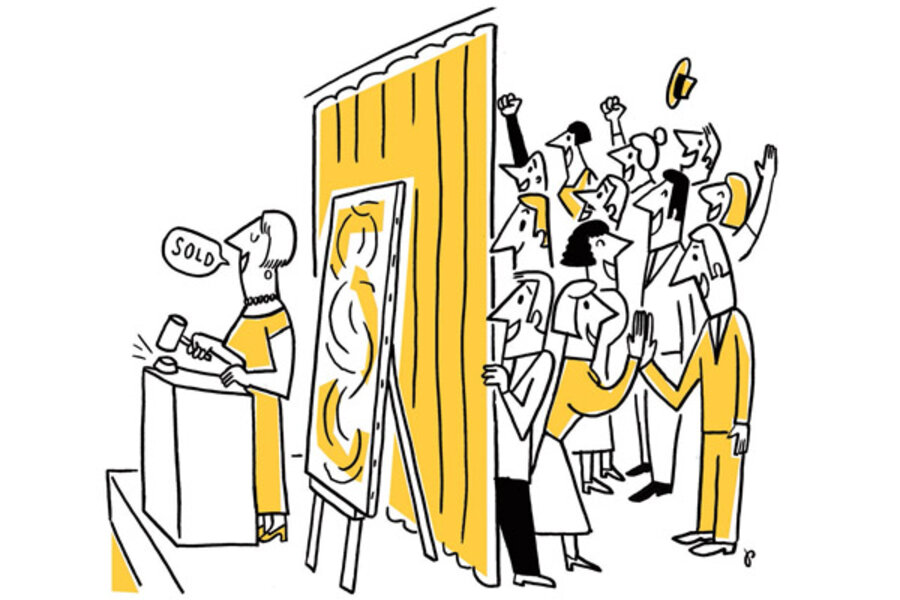Art market: masterful returns
Loading...
| New York
When The Collectors Fund, an art investment fund, debuted in 2007, art collectors Michael and Karen Herman were quick to sign on.
The fund had sterling attractions. It specialized in American art of the 20th and 21st centuries; the chairman's family founded the Kemper Museum of Contemporary Art in Kansas City, Mo. The fund lends investors its art holdings on a rotating basis. And the investment results? A masterpiece.
In its three years, the nearly $20 million fund has returned 28.5 percent annually on sales from its collection. "That return beat art market indexes as well as the stock market," boasts Mr. Herman, who bought a Neil G. Welliver painting from the fund and upped his investment in the fund late last year.
Such financial gains among art collectors and art-fund investors are drawing notice. Amid a volatile stock market, a housing slump, and economic uncertainty around the world, a surge of money is flowing into art in quest of good returns, hedges against inflation, and, yes, the cachet of owning a Matisse or a Calder – or at least a share of one.
Such forces are fueling prices of top-tier art. Picasso's Nude, Green Leaves and Bust, for example, fetched $106.5 million last year, a record auction price for a single piece of artwork. They're also inspiring the creation of new ways for investors to access the mysterious and often illiquid art market. "Art is an asset class, and investors are starting to recognize that," says Enrique Liberman, chairman and president of the new Art Fund Association, based in New York City.
One sign of the broadening investor interest is the appearance of new art-market indexes and art databases, such as Skate's Top 5000, a ranking of premier artworks based on their auction prices. Experts say new art funds, which operate like private-equity funds for wealthy individuals, are also on the drawing boards after a decade in which many of those planned or launched fizzled.
Moreover, in the past year, two nascent art exchanges have started up, one in Shenzhen, China, and the other in Paris. Last July, according to published reports, Shenzhen's Cultural Assets and Equity Exchange launched the trading of shares in a portfolio of 12 artworks. This January, the Art Exchange in Paris began trading in shares of individual artworks from participating galleries. Initial shares were selling for €10 ($14) apiece.
The timing seems propitious: Last year, the Mei Moses All Art index rebounded 16.6 percent after a two-year slump, slightly beating the Standard & Poor's 500 stock index. The Mei Moses index, which tracks the returns of art sold at auctions more than once, also bested the S&P 500 over five and 10 years, data show.
For those aiming to seize such opportunities, an art fund provides one avenue of investment. Investors own shares of a fund but not the underlying art. Proponents say this offers distinct advantages.
For example, there's diversification. "Buying art pieces individually, someone might be able to afford only one-to-two art works," says Mr. Liberman. "But with a $200,000 check to a fund, you can get equity in a portfolio of 50 to 60 or more pieces of art," which helps hedge against any one artist's work declining in value.
Not everyone is enthused. Nate Kacew, an art collector and a principal in a New York City marketing firm, prefers to own the art itself. Prominent New York City art dealer Richard Feigen says, "There's no good way for the public to access the art market except by getting good advice and buying art works individually."
Currently, in the United States and Europe, there is only "a handful of art funds being sold" that are available to qualified members of the "public and registered and [often] sold through wealth advisers," says Michael Plummer, a principal at New York City-based Artvest Partners, an art investment advisory firm.
Collectively, existing funds' assets total "no more than $200 million," he estimates, out of an art market that carried out $57.5 billion of transactions in 2010. Although new funds are now "in discussion," they would need the backing of a major bank or auction house to attract assets in the hundreds of millions of dollars, he says. "Most funds would aim to be that size."
The Collectors Fund, however, has done well on a much smaller scale. Its first offering, called the American Masters Collection 1, has already reached its financial goal and is closed to new investors, reports its chairman, Alexander Kemper. That 10-year fund, which required a minimum investment of $132,000, was available only to qualified high-income and/or high net-worth investors.
Cayman Islands-based Artemundi Global Fund, which debuted last April, "is currently about one-third of the way toward its goal of becoming $150 million-to-$225 million," reports the fund's CEO, Javier Lumbreras, who manages it from Mexico City. The fund requires a $250,000 minimum investment for individuals.
Its diversified portfolio ranges from old masters, to 19th century impressionists, to postwar and contemporary art. Its collections include such well-known Latin American artists as Frida Kahlo.
It's faring well so far, by all appearances. In its first year, the fund sold 20.7 percent of its holdings, achieving an average 150 percent return on each painting sold, Mr. Lumbreras says.





